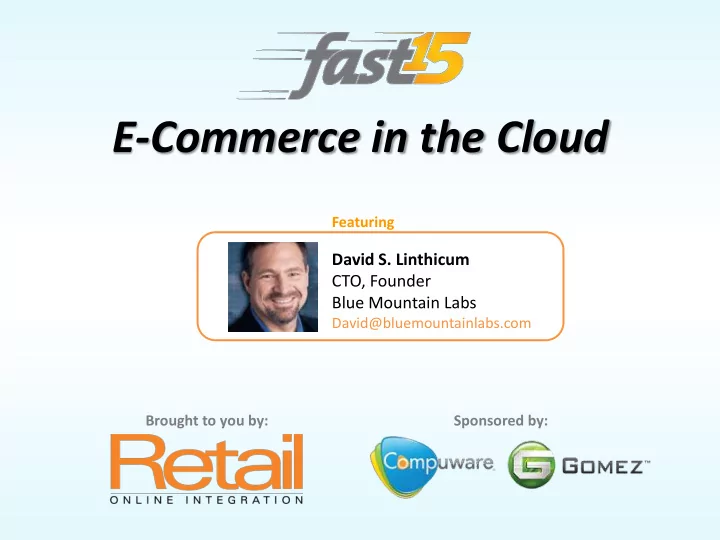

E-Commerce in the Cloud Featuring David S. Linthicum CTO, Founder Blue Mountain Labs David@bluemountainlabs.com Brought to you by: Sponsored by:
THREE LAYERS OF CLOUD COMPUTING Software as a Service (SaaS) Finished applications that you rent and customize (e.g., Salesforce.com) Platform as a Service (PaaS) Developer platform that abstracts the infrastructure, OS and middleware to drive developer productivity (e.g., Force.com) Infrastructure as a Service (IaaS) Deployment platform that abstracts the infrastructure (e.g., Amazon Web Services)
NIST defines cloud computing as a set of characteristics, delivery models, and deployment models 5 Characteristics On-demand self-service 3 Delivery Models Ubiquitous network Software as a Service access 4 Deployment Models (SaaS) Resource pooling Private Cloud Platform as a Service (PaaS) Rapid elasticity Community Cloud Infrastructure as a Pay per use Public Cloud Service (IaaS) Hybrid Cloud
ORGANIZING THE CLOUDS Testing-as-a-Service Management/Governance-as-a-Service Application-as-a-Service Integration-as-a-Service Security-as-a-Service Process-as-a-Service Platform-as-a-Service Information-as-a-Service Database-as-a-Service Storage-as-a-Service Infrastructure-as-a-Service
WHY CLOUD? The existing trajectory is not good. $ Capability
WHY IT MAKES SENSE Cloud Economics vs. Traditional IT With the cloud, you use and pay for only what you need . Capital Expenditure Not enough capacity, increased costs and Capacity: dissatisfied clients Capital Expenditure Compute, Storage, IT Labor, Real Estate Capital Expenditure Underutilized but still have capacity expenses Capital Expenditure Traditional Provisioning Capital Expenditure Cloud Provisioning Actual Usage Time
“ For the cloud, we're all in. ”
CLOUD POPULARITY = HYPE Source: CA
PATH TO THE CLOUDS Path to clouds: start with the architecture Understand: • Mission drivers • Information under management • Existing services under management • Core business processes
A STEP-BY-STEP GUIDE FOR DEPLOYING E-COMMERCE SYSTEMS IN THE CLOUD
STEP 1: UNDERSTAND THE BUSINESS CASE. While it would seem that moving to the cloud is a technology exercise, the reality is that the core business case should be understood as to the potential benefits of cloud computing. This is the first step because there is no need to continue if we can ’ t make a business case. Things to consider include the value of shifting risk to the cloud computing provider, the value of on- demand scaling (which has a high value in the world of ecommerce), and the value of outsourcing versus in-sourcing.
STEP 2: UNDERSTAND YOUR EXISTING DATA, SERVICES, PROCESSES, AND APPLICATIONS. You start with what you have, and cloud computing is no exception. You need to have a data-level, service-level, and process-level understanding of your existing problem domain, also how everything is bundled into applications. I covered this in detail in my book, but the short answer is to break your existing system or systems down to a functional primitive of any architectural components, or data, services, and processes, with the intention being to assemble them as components that reside in the cloud and on-premise.
STEP 3: SELECT A PROVIDER. Once you understand what you need, it ’ s time to see where you ’ re going. Selecting a cloud computing provider, or, in many cases, several, is much like selecting other on-premise technologies. You line up your requirements on one side, and look at the features and functions of the providers on the other. Also, make sure to consider the soft issues such as viability in the marketplace over time, as well as security, governance, points-of-presence near your customers, and ongoing costs.
STEP 4: MIGRATE. In this step we migrate the right architectural assets to the cloud, including transferring and translating the data for the new environment, as well as localizing the applications, services, and processes. Migration takes a great deal of planning to pull off successfully the first time.
STEP 5: DEPLOY. Once your system is on the cloud computing platform, it ’ s time to deploy it or turn it into a production system. Typically this means some additional coding and changes to the core data, as well as standing up core security and governance systems. Moreover, you must do initial integration testing, and create any links back to on- premise systems that need to communicate with the newly deployed cloud computing systems.
STEP 6: TEST. Hopefully, everything works correctly on your new cloud computing provider. Now you must verify that through testing. You need to approach this a few ways, including functional testing, or how your ecommerce system works in production, as well as performance testing, testing elasticity of scaling, security and penetration testing.
CLOUD COMPUTING A Fit When: Not A Fit When: Processes, applications, and data Processes, applications, and data are largely independent are largely coupled Points of integration are Points of integration are well defined not well defined Lower level of security is fine Higher level of security is required Core internal enterprise Core internal enterprise architecture is healthy architecture needs work Web is the The application requires desired platform a native interface Cost is an issue Cost is an issue Applications are new Application is legacy
Big THANKS for Joining Us Today! To learn more about ROI eLearning events: www.retailonlineintegration.com/webinar
Recommend
More recommend